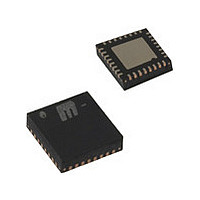MICRF505BML TR Micrel Inc, MICRF505BML TR Datasheet - Page 22

MICRF505BML TR
Manufacturer Part Number
MICRF505BML TR
Description
Manufacturer
Micrel Inc
Datasheet
1.MICRF505BML_TR.pdf
(42 pages)
Specifications of MICRF505BML TR
Operating Temperature (min)
-40C
Operating Temperature (max)
85C
Operating Temperature Classification
Industrial
Modulation Type
FSK
Lead Free Status / Rohs Status
Not Compliant
0010101
0010110
A6..A0
FEE
The
information from the demodulator to calculate the
frequency offset between it’s receive frequency and
the transmitter frequency. The output of the FEE can
be used to tune the XCO frequency, both for
production calibration and for compensation for
crystal temperature drift and aging.
The inputs to the FEE circuit are the UP and DN
pulses from the demodulator. Every time a ‘1’ is
updated, an UP-pulse is coming out of the
demodulator and the same with the DN-pulse every
time the ‘0’ is updated. The expected number of
pulses for every received symbol is 2 times the
modulation index ( ∆ ).
The FEE can be set in an off state or set to count
the UP+DN pulses. The number of received symbols
to be counted is 8, 16, 32 or 64. This is set by the
FEEC_0…FEEC_3 control bit, as follows:
FEEC_1
FEEC_3
October 2006
0
0
1
1
0
0
1
1
FEE_7
D7
-
Frequency
FEE_6
FEEC_0
FEEC_2
D6
-
Table 10. FEEC Control Bit
1
0
1
0
1
0
1
0
FEE_5
D5
-
Error
FEE Mode
Off
Not in use
Not in use
Counting UP and DN pulses. UP increments
the counter, DN decrements it.
No. of symbols used for the measurement
8
16
32
65
FEE_4
D4
-
Estimator
FEEC_3
FEE_3
D3
FEEC_2
FEE_2
D2
(FEE)
FEEC_1
FEE_1
D1
uses
FEEC_0
FEE_0
D0
22
The result of the measurement is the FEE value.
The 8bit value can be read from register with
address 0010110b. After a load, the FEE will be
reset to 0, and will then be incremented or
decremented dependent of the frequency offset.
Positive FEE values are in the range 0 – 127, and
negative values in the range 128 – 255. For negative
values, the twos complement of the FEE value need
to be found before using the formula below. A FEE =
128 corresponds
corresponds to ÷1.
When the FEE value has been read, the frequency
offset can be calculated as follows:
where FEE is the value stored in the FEE register,
(P is the number of symbols/data bit counted and R
is the symbol/data rate. A positive Foffset means
that the received signal has a higher frequency than
the receiver frequency. To compensate for this, the
receivers XCO frequency should be increased (see
‘Using the XCO-tune Bits on how to tune the XCO
frequency based on the FEE value).
The most accurate reading will be achieved when
counting many symbols/data (P). However, attention
must be paid to the negative representation of the
FEE value. If the frequency offset is too large for the
chosen P, and the FEE is being incremented above
+127, the FEE value will be interpreted as a
negative number. If so, the P must be decremented.
Mode UP+DN: Foffset = R/(4P)x(FEE),
to ÷127 and FEE
+1 408-944-0800
M9999-103106
= 255











